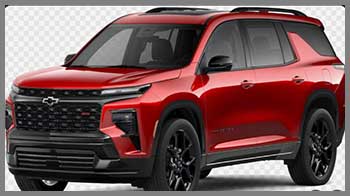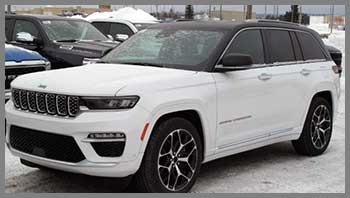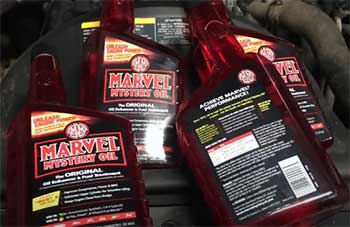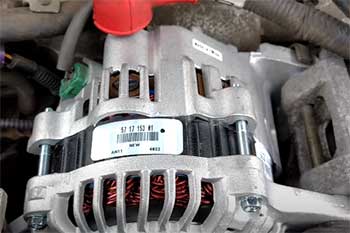As an avid golfer, I’ve spent countless weekends hauling my clubs to courses near and far, always on the lookout for a vehicle that complements my passion.
The Chevrolet Traverse and Jeep Grand Cherokee are two midsize SUVs that promise to elevate the golfing experience with their blend of space, comfort, and capability, and this article aims to help golfers choose the right one for their needs.
This guide will cover everything from cargo space to off-road prowess, ensuring you find the perfect SUV for your golfing adventures.
Comparison Table: Chevrolet Traverse Vs. Jeep Grand Cherokee
| Feature | Chevrolet Traverse | Jeep Grand Cherokee |
| Starting MSRP | $41,995 | $38,490 |
| Seating Capacity | Up to 8 passengers | Up to 5 passengers (7 in L model) |
| Cargo Space (Behind 1st Row) | 97.6 cu. ft. | 70.8 cu. ft. (84.6 cu. ft. in L model) |
| Max Towing Capacity | 5,000 lbs | 6,200 lbs (7,200 lbs with V8) |
| Engine Power | 328 hp (2.5L Turbo I4) | 293 hp (3.6L V6) |
| Fuel Economy (City/Hwy) | 20/27 mpg | 19/26 mpg |
| Infotainment Screen | 17.7-inch touchscreen | 8.4-inch or 10.1-inch touchscreen |
| Off-Road Capability | Moderate (AWD available) | Superior (4×4, terrain modes) |
| Third-Row Seating | Standard | Optional (Grand Cherokee L only) |
| Safety Features | Super Cruise, Lane Keep Assist | Blind-Spot Monitoring, ParkSense |
My Journey With Midsize SUVs
My love for SUVs stems from their versatility, perfect for carrying golf bags, coolers, and friends to the course while handling the occasional backroad to a hidden gem of a golf resort. As a mid-handicap golfer who enjoys both local rounds and weekend golf trips, I need a vehicle that balances space, comfort, and reliability.
To compare the Traverse and Grand Cherokee, I test-drove both over a mix of city streets, highways, and light off-road trails near a golf course, loading them with gear to simulate a typical golf outing.
Key Features Of Chevrolet Traverse

- Design Philosophy & Target User: The Chevrolet Traverse is designed for families and group travelers, prioritizing spaciousness and modern tech for everyday comfort. Its roomy interior and third-row seating make it ideal for golfers who travel with family or a large group of buddies.
- Specific Features:
- Cargo Space: With 97.6 cu. ft. of cargo space behind the first row, the Traverse easily swallows multiple golf bags, carts, and extra gear, perfect for a weekend tournament.
- Infotainment System: The 17.7-inch touchscreen is a standout, offering intuitive navigation and Apple CarPlay/Android Auto integration, keeping you connected to tee-time apps or music on long drives.
- Super Cruise: Available hands-free driving tech enhances highway comfort, letting you relax on the way to distant courses.
- Summary: The Traverse is best suited for golfers prioritizing space and tech for group trips.
Read more: My Thoughts on Honda Passport Vs. Acura RDX.
Key Features Of Jeep Grand Cherokee
- Design Philosophy & Target User: The Jeep Grand Cherokee is built for adventure-seekers who value off-road capability and refined performance. It appeals to golfers who frequent courses with rugged access roads or enjoy combining golf with outdoor exploration.
- Specific Features:
- Off-Road Capability: With available 4×4 systems and terrain management, the Grand Cherokee tackles dirt roads or muddy paths to remote courses with ease.
- Towing Capacity: Its 6,200-lb towing capacity (up to 7,200 lbs with the V8) is perfect for golfers towing trailers with golf carts or other equipment.
- Uconnect System: The 8.4-inch or optional 10.1-inch touchscreen is user-friendly, with off-road-focused features like trail maps that can guide you to less accessible courses.
- Summary: The Grand Cherokee is ideal for golfers who value rugged versatility and premium features.
Pros Of Chevrolet Traverse
- Spacious Interior: The Traverse’s ability to seat up to eight and its 97.6 cu. ft. of cargo space made loading four golf bags, a cooler, and extra gear effortless during a group outing to a local course.
- Advanced Tech: The 17.7-inch touchscreen and Super Cruise system impressed me on a 200-mile trip to a resort course, making navigation and long drives stress-free.
- Affordability: Starting at $41,995, it’s competitively priced for its size and features, offering great value for family-oriented golfers.
Cons Of Chevrolet Traverse
- Limited Off-Road Ability: While AWD is available, the Traverse struggled on a muddy access road to a rural course, lacking the grip of a true off-roader.
- Fuel Economy: At 20/27 mpg, it’s slightly better than the Grand Cherokee but still a consideration for frequent long-distance golfers.
- Less Premium Feel: The interior, while spacious, uses materials that feel less upscale than the Grand Cherokee’s, which might disappoint golfers seeking luxury.
Pros Of Jeep Grand Cherokee

- Off-Road Prowess: On a trip to a course with a gravelly access road, the Grand Cherokee’s 4×4 system and 8.6-inch ground clearance handled the terrain with confidence.
- Towing Strength: Its 6,200-lb towing capacity allowed me to easily haul a small trailer with a golf cart, a game-changer for tournament days.
- Luxury Options: Higher trims offer premium features like Nappa leather and a 19-speaker McIntosh sound system, elevating the drive to upscale courses.
Cons Of Jeep Grand Cherokee
- Smaller Cargo Space: With 70.8 cu. ft. (or 84.6 cu. ft. in the L model), it’s less spacious than the Traverse, requiring careful packing for four golf bags.
- Higher Price in Upper Trims: While starting at $38,490, loaded models can exceed $65,000, a steep jump for budget-conscious golfers.
- Reliability Concerns: Some reports note Jeep’s reliability lags behind competitors, which could be a concern for frequent travelers.
Analytical Breakdown: How They Compare On The Road
- Brief Intro: To compare the Traverse and Grand Cherokee, I tested both over a weekend golf trip, including highway drives, city commutes, and a light off-road trail to a course.
- Cargo and Gear Storage: The Traverse’s 97.6 cu. ft. of cargo space outperformed the Grand Cherokee’s 70.8 cu. ft., easily fitting four golf bags, a pushcart, and a cooler without folding seats. The Grand Cherokee L’s 84.6 cu. ft. was better but still required more strategic packing.
- Comfort and Ride Quality: The Traverse’s spacious cabin and 41 inches of front legroom felt airy for long drives, but the Grand Cherokee’s available Nappa leather and adjustable seats offered a more premium ride, especially on bumpy roads.
- Off-Road Performance: The Grand Cherokee shone on a muddy trail to a rural course, with its terrain management system ensuring stability. The Traverse’s AWD was adequate but struggled in deeper mud.
- Fuel Efficiency: The Traverse’s 20/27 mpg edged out the Grand Cherokee’s 19/26 mpg, saving about $50 over a 1,000-mile trip at $3/gallon.
- Price and Value: The Traverse’s $41,995 base price offers more space and tech for the money, while the Grand Cherokee’s $38,490 starting point is appealing, but its higher trims reduce its value proposition.
Who Should Choose Which SUV?
- Recommendation for Chevrolet Traverse: Ideal for golfers with large groups or families, needing maximum cargo space and modern tech. Best for mid-handicap players prioritizing affordability and space over off-road ability.
- Recommendation for Jeep Grand Cherokee: Suited for golfers who frequent remote courses or combine golf with outdoor adventures. Perfect for those valuing towing capacity and luxury, with a mid-to-high budget.
My Real-World Experience

- Detailed Anecdote 1: On a trip to a coastal course, the Traverse’s massive cargo area allowed me to pack four golf bags, a cooler, and beach chairs without folding the third row, making it a breeze to transition from golf to a post-round beach hangout. The Grand Cherokee, however, required folding seats, which felt less convenient.
- Detailed Anecdote 2: Driving to a mountain course with a gravel access road, the Grand Cherokee’s 4×4 system navigated the uneven terrain effortlessly, boosting my confidence. The Traverse, while stable on paved roads, felt less secure on the same path, requiring slower speeds.
Why These SUVs Matter For Amateurs
- General Statement: Both the Traverse and Grand Cherokee are designed to cater to everyday drivers, including amateur golfers who need reliable, versatile vehicles.
- Benefits for Amateurs: The Traverse’s spaciousness and affordability make it a practical choice for group outings, while the Grand Cherokee’s off-road capability and premium features appeal to those seeking adventure and luxury.
- Reiteration of Choice: The decision hinges on whether you prioritize space and tech (Traverse) or rugged versatility and towing (Grand Cherokee), with no single “best” option.
Also read: My Thoughts on Honda Acura Integra Vs. Honda Accord.
Frequently Asked Questions (Faq)
Golfers with large families or groups, needing ample cargo space and modern tech for group trips.
It offers 97.6 cu. ft. behind the first row, ideal for multiple golf bags and gear.
The Chevrolet Traverse excels for families due to its seating for eight and large cargo area.
While pros often use sponsored vehicles, midsize SUVs like the Traverse and Grand Cherokee are popular among amateurs for their practicality and versatility.
Conclusion
The Chevrolet Traverse shines for golfers needing space and affordability, while the Jeep Grand Cherokee excels for those prioritizing off-road capability and premium features. Your choice depends on your golfing lifestyle—group trips favor the Traverse, while adventurous drives lean toward the Grand Cherokee.

